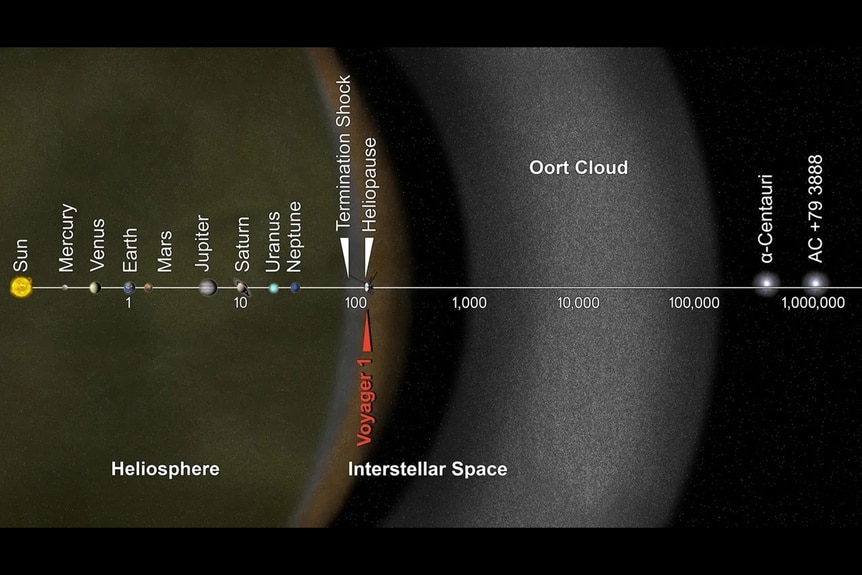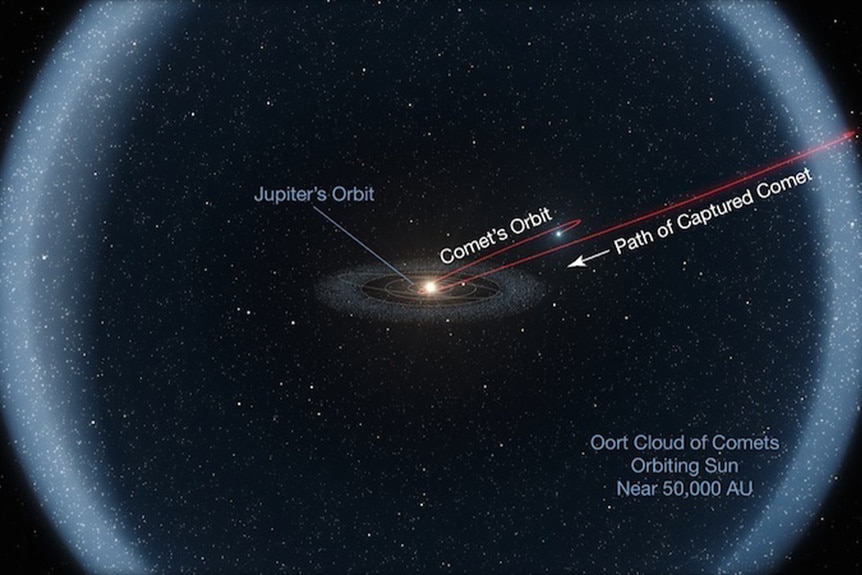Create a free profile to get unlimited access to exclusive videos, sweepstakes, and more!
Your Cheat Sheet to the Solar System's Oort Cloud
It's a huge cloud of icy planetesimals up to a light-year from here.
SYFY’s The Ark takes viewers along for the ride on a one-way trip to Proxima centauri, a star 4.2 light-years from here. It’s a staggering trip which requires technology a century more advanced than our own; just getting out of the solar system is an overwhelming task. Their trip would have begun by passing through the inner system, past Mars and the asteroid belt, on to the gas giants and the ice giants, before passing beyond the orbit of Pluto in the Kuiper Belt.
By then, the scenery would have all but fallen away to nearly empty space, but they wouldn’t have been out of the system yet. First, they needed to pass through a vast spherical field of loosely scattered icy bodies known as the Oort cloud.
It’s one of the least studied and most mysterious regions in our cosmic neighborhood, existing at the boundary between the solar system and interstellar space. The Oort cloud takes its name from astronomer Jan Oort, who proposed the cloud as a possible origin for long-period comets in 1950. While Oort’s name has become synonymous with the distant cloud of planetary leftovers, he wasn’t the first to suggest it. Estonian astronomer Ernst Öpik suggested its existence 18 years earlier. As a result, it is sometimes called the Öpik-Oort cloud.
For More on the Oort Cloud:
An Asteroid is About to Embark on a Very Long Voyage to Interstellar Space
Dwarf Planet FarFarOut is Further Than Anything We've Seen in Our Solar System
Over Time, Some Stars Get Uncomfortably Close to the Sun
How Far Away Is the Oort Cloud?
Earth lies in the inner solar system, the local equivalent of the big city. In our neck of the woods, things are relatively close together and fast moving. If Earth is the planet that never sleeps then the Oort cloud is where you go to retire away from it all, far from the bright lights and bustling planets of the inner system. It exists at the outer fringes, the frozen, dark wastelands of the solar system. Getting there is a slog!
Starting at the Sun, there’s a 93-million-mile commute to Earth. Much farther than that and it stops making sense to measure in miles. Astronomers use that 93-million-mile distance, the average orbital distance of the Earth, as a unit of distance called an astronomical unit (AU). To get a sense of scale, Mars is about 1.5 AU from the Sun, Jupiter is about 5 AU, Saturn is 9.5 AU, and Pluto sits a staggering average distance of 39 AU. The New Horizons spacecraft set off for Pluto in January 2006 and didn’t get there until 9.5 years later. It’s a long way, but it’s nothing compared to the Oort cloud.
The starting line for the Oort cloud is somewhere between 2,000 and 5,000 AU and it extends up to 100,000 AU, roughly 1.5 light-years from here. It’s so far away and so vast that the Voyager spacecraft, traveling a million miles per day, won’t enter it for 300 years, and it won’t reach the other side until the year 302,024, give or take a few thousand years.
What Is the Oort Cloud Made Of?
The chunks of ice and rock that makes up the Oort cloud probably formed much closer to the Sun during the early days of the solar system’s formation. As the protoplanetary disk came together into planets, moons, and the Sun, a bunch of material got left over, gathered into planetesimals that didn’t quite get it together enough to become a world.
As the solar system evolved, all of that leftover debris got pushed around. Some of it made its way toward the inner system where it crashed into planets or flew too close to the Sun and was destroyed. Some of it got pushed farther out where the Sun’s influence is weaker, and the tidal pull of interstellar space takes the lead. That far from the Sun, the ecliptic plane loses all sway, and objects in the Oort cloud orbit at pretty much any inclination. Objects in the Oort are gravitationally bound to the Sun but only loosely. They are also influenced by other stars, and from the tidal pull of the galaxy as a whole, and that cosmic tug of war causes them to settle into nicely circular orbits. It’s a tenuous balance, disturbances from other stars or from the Milky Way can kick objects out of their orbit and on a long-period path toward the Sun.
It’s possible that long-period comets from the Oort cloud sometimes get kicked closer to the Sun and get stuck, becoming short-period comets like Halley. For the most part, Oort objects stay in the boondocks, only occasionally visiting our neck of the woods. In October 2014, the Oort comet Siding Spring made a close pass of Mars before going back to the cosmic suburbs. It won’t come back into the inner system for another 740,000 years.
Studying the Oort cloud from Earth is a challenge because tiny meteors tens of thousands of AU away aren’t great targets for telescopes. If we really want to get a handle on the Oort cloud, we might have to wait for an interstellar mission to go there ourselves.
Catch up with the crew of the Ark One when The Ark returns for Season 2!




































